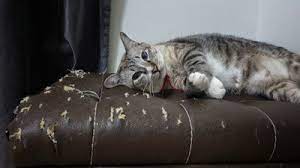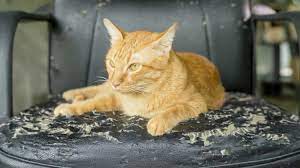
How To Keep Your Leather Couch From Getting Cats Scratches
If you have a leather couch, you know how important it is to keep it looking its best. But if you have cats, you also know how difficult it can be to keep them from scratching the leather. Here are some tips on how to repair leather scratches from cats and keep your couch looking great:
First, start by trimming your cat’s nails regularly. This will help prevent them from doing too much damage when they scratch.
If your cat does happen to scratch your leather couch, there are a few ways to fix the scratches. One way is to use a leather repair kit. These kits usually come with a filler that you can use to fill in the scratch. Another way is to use a matching leather dye to cover up the scratch.
Whatever method you choose, make sure you test it on a small area of the couch first before using it on the entire couch. This will help you avoid any further damage to your beloved furniture.
can you repair patent leather?
If your cat has already scratched up your leather couch, you might be wondering if there is anything you can do to repair the damage. While it is possible to repair some types of leather damage, unfortunately, patent leather is not one of them.
Patent leather is a type of coated leather that has a shiny, plastic-like finish. This finish is achieved by applying a coating of polyurethane or varnish to the leather. This coating is what makes patent leather so durable and easy to clean, but it also makes it very difficult to repair once it has been damaged.
If your cat has scratched your patent leather couch, you will likely need to replace the damaged area with new patent leather. This can be done by cutting out the damaged area and attaching new patent leather to it. While this is not an easy task, it is possible to do it yourself if you are handy with a sewing machine.
If you are not confident in your ability to repair the damage yourself, you can always take your couch to a professional upholsterer or furniture repair specialist. They will be able to patch the damage and make your couch look new again.
How to keep your leather couch from getting cats scratched – use a repair kit
If you have a leather couch that is starting to show signs of wear and tear from your cats, there are ways to help repair the damage. One option is to purchase a leather repair kit, which can be found at most home improvement or hardware stores. These kits usually come with a color chart to help you find the right match for your couch, as well as instructions on how to apply the repair material. In most cases, all you need is a little bit of time and patience to make your couch look like new again.
How to repair leather door armrest in the car – use a leather conditioner
If your leather door armrest is looking dry and cracked, you can use a leather conditioner to help repair it. First, clean the area with a damp cloth to remove any dirt or debris. Then, apply the conditioner evenly over the surface of the armrest. Let it sit for several minutes before wiping it off with a soft cloth. You should see an immediate improvement in the appearance of your armrest!
How to protect your leather furniture from pets – use furniture covers
when you’re not home and keep your pet’s nails trimmed.

If you have a pet, chances are your leather furniture has taken a beating. Pets can be tough on furniture, especially if they’re allowed to jump on or off of it. Fortunately, there are some things you can do to protect your leather furniture from pets.
One of the best ways to protect your leather furniture is to use covers when you’re not home. This will prevent your pet from scratching or chewing on the leather. You can find covers specifically designed for leather furniture at most home improvement stores.
Another way to protect your leather furniture is to keep your pet’s nails trimmed. Long nails can easily scratch and damage leather surfaces. If you can’t trim your pet’s nails yourself, take them to a groomer or vet for help.
Place a throw blanket or piece of furniture over the area where your cat likes to scratch.
If your cat enjoys scratching furniture, place a throw blanket or piece of furniture over the area where they like to scratch. This will give them a designated spot to scratch and hopefully deter them from ruining your furniture.
Train your cat with positive reinforcement to scratch elsewhere.
Cats enjoy scratching because it helps them stretch and groom their claws. However, this can quickly become a problem for owners when furniture or other household items are the target of their cat’s scratching. The best way to train your cat to scratch elsewhere is with positive reinforcement.
When you see your cat scratching in an appropriate place, such as a scratching post, immediately give them praise and affection. You can also offer them a treat as a further reward. Over time, your cat will learn that good thing happen when they scratch in the right place.
how to repair leather door armrests in a car
If you have a leather door armrest in your car, you may be wondering how to repair it if it gets scratched by your cat. There are a few things you can do to fix this problem.
One option is to use a leather repair kit. These kits come with a variety of tools and materials that you can use to patch up small scratches. Make sure to follow the instructions carefully so that you don’t damage the armrest further.
Another option is to take the armrest to a professional leather repair shop. They will have the tools and expertise to fix the armrest without damaging it further. This is usually the best option if the armrest is severely scratched.
If you decide to try and fix the armrest yourself, make sure you have plenty of time and patience. It’s important to take your time so that you don’t damage the armrest further. With a little bit of effort, you should be able to fix the scratches on your leather door armrest.